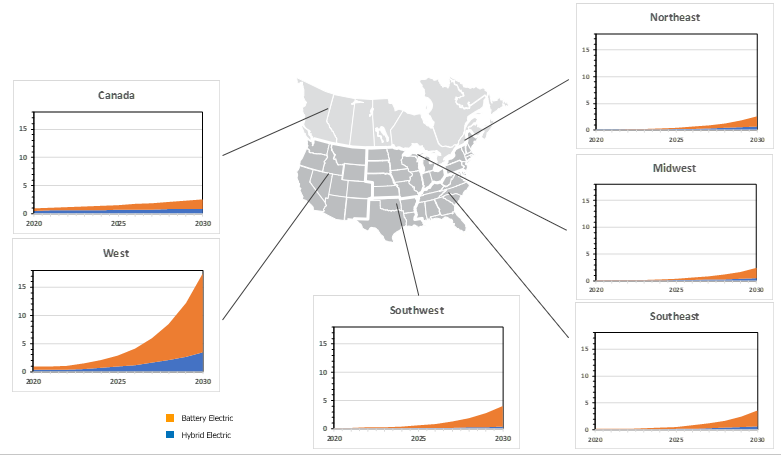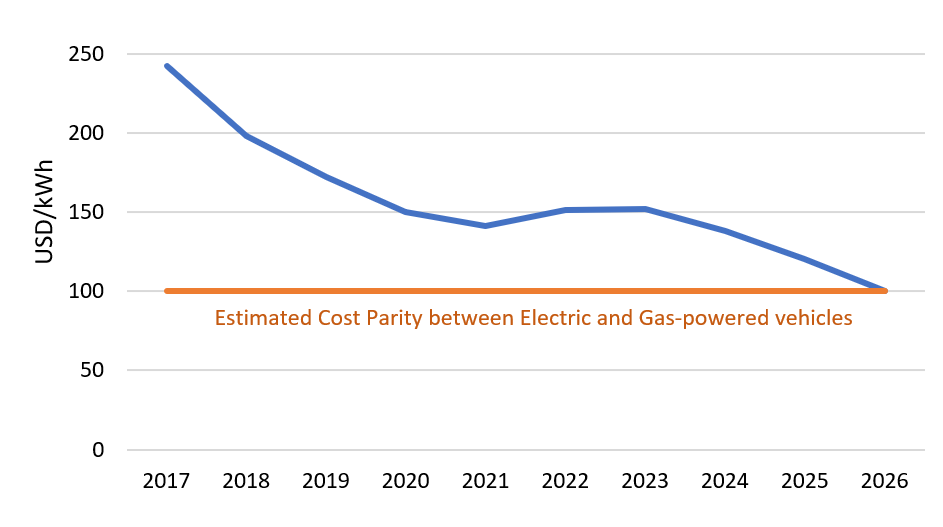Your cart is currently empty!
Cobalt For BEV Batteries 2010-2030



January 8, 2024
Cobalt utilized in batteries has grown from virtually nil in 2010 to over 80,000 tonnes in 2022. Incorrys is forecasting accelerating growth with global demand reaching over 350,000 tonnes by 2030.

December 25, 2023
Global nickel production has generally been in an upward trend growing from over 1.5 million tonnes in 2010 to 3.3 million tonnes in 2022.

January 8, 2024
Lithium used in BEV cars has grown from essentially nothing in 2010 to 11,000 tonnes in 2020 however, the growth is expected to accelerate through to 2030 increasing to about 175,000 tonnes.

February 26, 2024
Conventional cars with internal combustion engines (ICEs) use the least amount of copper compared to all electric vehicle (EV) types at under 25 kg/vehicle.

February 26, 2024
Copper used in BEV cars has grown from 1 thousand tonnes in 2010 to 1 million tonnes in 2023. Demand is expected to accelerate through to 2030 increasing to about 3.6 million tonnes.
![]()
March 24, 2023
Since the first half of 2020, the auto industry has been facing a systematic decline in production primarily due to the Covid-19 pandemic that heavily impacted manufacturing for a long while and has since contributed to supply chain disruptions of most items, including auto parts. One of the casualties of this has been the crisis in the semiconductor industry, not only from manufacturing and supply chain disruptions, but also stiff competition from home computers as more and more people began working from home.

February 22, 2023
The average retail price, in USD, of Battery Electric Vehicles (BEVs) by production year for 2020 through 2023. Additional Charts showing the Standard Deviation of the Retail Price of BEVs, Number of BEV Models Worldwide, Battery Capacities, and Retail Price vs. Battery Capacity.
The global car industry is still in the process of transitioning toward EVs which is expected to take at least another 5-7 years. However, the price of EVs relative to those of gasoline vehicles are expected to decrease after 2024-2025, while battery capacity will continue to grow. Overall, customers now have a greater variety of BEV models to choose from ranging from more affordable to luxury.

April 15, 2023
Forecast to 2030 of the total number of electric vehicles (cars, light commercial vehicles, buses and trucks) worldwide. Additional chart illustrating Incorrys Electric Vehicle Forecast model.
Incorrys analyzed both battery electric vehicles (BEV) and plugin hybrid electric vehicles (PHEV). Incorrys estimates total registered electric vehicles worldwide will grow almost 20 times from 10.7 million in 2020 to almost 200 million 2030.

April 15, 2023
Market share of new electric vehicles (EV) by region for 2022, led by Norway, Iceland, Sweden, and Denmark.
In general, the results demonstrate the extraordinary performance of some governments in their activities to support manufacturers of EVs and batteries, as well as the installation of charging stations.

April 13, 2023
Number of battery electric vehicles (BEV) and hybrid plug-in electric vehicles (PHEV) from 2020-2022.
Global EVs have increased from about 11 million in 2020 to 27 million in 2022 – an increase of 150% in 3 short years. China represented 37% of the 2022 global EV stock.

April 14, 2023
The number of battery and hybrid plugin electric light commercial vehicles (ELCV) in 2022.
Total number of all LCV worldwide in 2022 was 491,000. China accounted for almost half of all electric LCVs while Europe accounted for almost 28%, and North America 19%.

April 16, 2023
Global trend in light vehicle sales comparing EVs to total light vehicles. Additional chart showing total electric vehicle sales trends by region.
In 2023, the total number of light vehicles is expected to reach 84 million. It is forecast to increase at an annual average rate of about 4.5% reaching 114 million in 2030.

April 16, 2023
Annual sales of electric vehicles (EV) in 2030 by EV type (car, van, trucks, and buses) and by region including China, Europe, US, and India. Additional chart showing market share by region.
Based on a sustainable development scenario, Incorrys expects the global sales of electric vehicles to reach 38 million in 2030.

June 18, 2021
Total number of registered electric vehicles (EV) in North America by region to 2030.
In total, the number of electric vehicles registered in North America grows twelvefold between 2020 and 2030. The US West is expected to show the most growth and accounts for over half of the total North American market.

April 16, 2023
Forecast to 2030 of the total number of battery electric vehicles (BEV) and plugin hybrid electric vehicles (PHVE) in the US (cars, LCV’s and trucks and buses). Additional chart illustrating Incorrys Electric Vehicle Forecast model.
Incorrys expects the total number of registered electric vehicles in the US to reach 28 million in 2030, up from just 1.6 million in 2020.

April 15, 2023
Average battery pack prices are forecast to reach USD $100/kWh (Incorry’s threshold for price parity between electric and gas-powered cars) by 2026, two years later than previously projected.
The battery pack is the most expensive component of electrical vehicles and critical to achieve a cost parity with internal combustion engine vehicles. Incorrys expects that the costs parity threshold with ICE will occur in 2025.

February 17, 2023
Incorrys analyzed data for almost 300 models of Battery Electric Vehicles (BEH) and compared the retail price against the kWh of battery capacity for the 2020 through 2023 production models.
The retail car price per kWh of battery capacity is expected to remain flat at around USD $1000/kWh for the next few years. One of the main reasons for flat retail prices and prices per kWh of battery capacity is the significant demand of electric vehicles (EVs) and BEVs, which has led to long waiting waiting times for delivery.

March 12, 2023
Range is one of the critical parameters of electric vehicle in the race to achieve parity with gasoline engines. Compares the average annual range (km) per charge for 2020-2023. Additional chart includes a scatter plot of all 295 electric vehicles analyzed for the model years 2020-2023 comparing retail price vs range per charge.
As the price of the vehicle increases so does the distance it can travel on a single charge. The average range per charge has increased from 240 km/charge in 2020 production models to over 400 km in 2023 models.

March 13, 2023
Electric vehicle efficiency is measured as power consumption(Wh) per kilometer traveled and the chart compares the average annual efficiency for 2020-2023 production models. Additional chart includes a scatter plot of all 295 electric vehicles analyzed for 2020-2023 compares the retail price of electric vehicles (EV) against the efficiency (measured in Watt hours /kilometer (Wh/km)) for 2020-23 models.
Average efficiency continues to improve due to the introduction of larger and heavier models. Average efficiency dropped 16% to 189 Wh/km for 2023 models from 226 Wh/km for 2020 models.

April 15, 2023
Publicly accessible slow and fast electric vehicle supply equipment (EVSE) stock globally in 2021 and 2022. Additional chart of the private and public market share of EVSE.
The total number of EVSE worldwide was 6.9 million. Publicly available EV charging accounted for 40% of the total (almost 3 million).

March 14, 2023
Changing time for electric vehicles is measured by range added per hour of charging. Compares the annual average distance per hour of charging for production years of 2020-2023. Additional charts include a table showing the specifics of various charger types, the average retail price per charge time, and a scatter plot of all 295 electric vehicles analyzed comparing retail price vs charging time.
The average distance per hour of charging has increased from about 400 km in 2020 models to over 600 km for 2023 models – an increase of 55%.